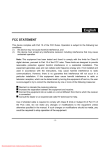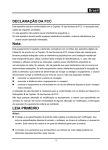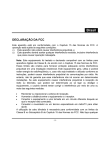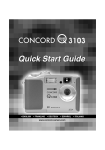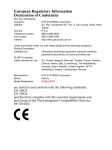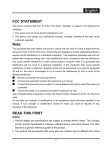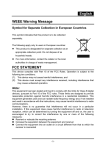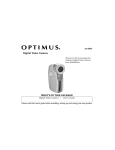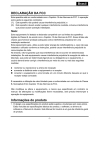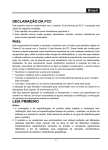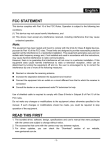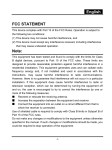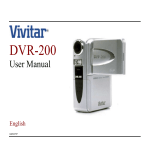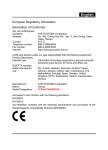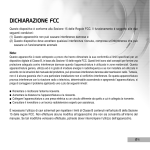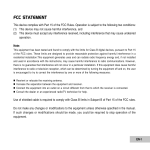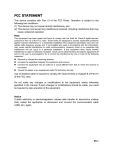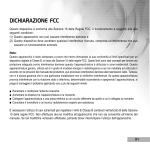Download English FCC STATEMENT Note: READ THIS FIRST
Transcript
English FCC STATEMENT This device complies with Part 15 of the FCC Rules. Operation is subject to the following two conditions: (1) This device may not cause harmful interference, and (2) This device must accept any interference received, including interference that may cause undesired operation. Note: This equipment has been tested and found to comply with the limits for Class B digital devices, pursuant to Part 15 of the FCC rules. These limits are designed to provide reasonable protection against harmful interference in a residential installation. This equipment generates uses and can radiate radio frequency energy and, if not installed and used in accordance with the instructions, may cause harmful interference to radio communications. However, there is no guarantee that interference will not occur in a particular installation. If this equipment does cause harmful interference to radio or television reception, which can be determined by turning the equipment off and on, the user is encouraged to try to correct the interference by one or more of the following measures: Reorient or relocate the receiving antenna. Increase the separation between the equipment and receiver. Connect the equipment into an outlet on a circuit different from that to which the receiver is connected. Use of shielded cable is required to comply with Class B limits in Subpart B of Part 15 of the FCC rules. Do not make any changes or modifications to the equipment unless otherwise specified in the manual. If such changes or modifications should be made, you could be required to stop operation of the equipment. READ THIS FIRST Notice: Product design and specifications are subject to change without notice. This includes primary product specifications, software, software drivers, and user’s manual. This User Manual is a general reference guide for the product. The product and accessories that come with your digital video camera may be different from those described in this manual. This is due to the fact that different retailers often specify -1- English slightly different product inclusions and accessories to suit their market requirements, customer demographics, and geographical preferences. Products very often vary between retailers especially with accessories such as batteries, chargers, AC adapters, memory cards, cables, carrying cases/pouches, and language support. Occasionally a retailer will specify a unique product color, appearance, and internal memory capacity. Contact your dealer for precise product definition and included accessories. The illustrations in this manual are for the purpose of explanation and may differ from the actual design of your digital video camera. The manufacturer assumes no liability for any errors or discrepancies in this user manual. For driver updates and revisions to this manual, please refer to our website www.geniusnet.com.tw. WARNING If foreign objects or water have entered the camera, turn the power OFF and remove the batteries. If the camera has fallen or its case has been damaged, turn the power OFF and remove the batteries. Continued use in this state might cause fire or electric shock. Consult the store of purchase. Do not disassemble, change or repair the camera. This might cause fire or electric shock. For repair or internal inspection, ask the store of purchase. Do not use the camera in areas near water. This might cause fire or electric shock. Take special care during rain, snow, on the beach, or near the shore. Do not place the camera on inclined or unstable surfaces. This might cause the camera to fall or tilt over, causing injury. Keep the batteries out of the reach of children. Swallowing batteries might cause poisoning. If the battery is accidentally swallowed, immediately consult a physician. Do not use the camera while you are walking, driving or riding a motorcycle. This might cause you to fall over or result in traffic accident. CAUTION Insert the batteries paying careful attention to the polarity (+ or –) of the terminals. Inserting the batteries with its polarities inverted might cause fire and injury, or damage to the surrounding areas due to the battery rupturing or leaking. Do not fire the flash close to anyone’s eyes. This might cause damage to the person’s -2- English eyesight. Do not subject the LCD monitor to impact. This might damage the glass on the screen or cause the internal fluid to leak. If the internal fluid enters your eyes or comes into contact with your body or clothes, rinse with fresh water. If the internal fluid has entered your eyes, consult a physician to receive treatment. A camera is a precision instrument. Do not drop it, strike it or use excessive force when handling the camera. This might cause damage to the camera. Do not use the camera in humid, steamy, smoky, or dusty places. This might cause fire or electric shock. Do not remove the battery immediately after long period of continuous use. The battery becomes hot during use. Touching a hot battery might cause burns. Do not wrap the camera or place it in cloth or blankets. This might cause heat to build up and deform the case, resulting in fire. Use the camera in a well ventilated place. Do not leave the camera in places where the temperature may rise significantly, such as inside a car. This might adversely affect the case or the parts inside, resulting in fire. Before you move the camera, disconnect cords and cables. Failure to do this might damage cords and cables, resulting in fire and electric shock. CAUTION When you use the battery, carefully read and strictly observe the Safety Instructions and the notes described below: Different battery types and surrounding temperatures may affect the battery performance. Avoid using batteries in extremely cold environments as low temperatures can shorten the battery life and reduce camera performance. This low temperature will also influence alkaline battery performance, therefore Ni-MH rechargeable battery is highly recommended. If you are using the new rechargeable batteries or rechargeable batteries that have not been used for an extended period of time (batteries that pass the expiry date are exceptions) might affect the number of pictures that can be taken. Therefore, to maximize their performance and lifetime, we recommend that you fully charge the batteries and discharge them for at least one complete cycle before use. The battery may feel warm when using the camera for an extended period of time or using the flash continuously. This is normal and not a malfunction. The camera may feel warm when being used continuously or for an extended period of time. This is normal and not a malfunction. -3- English If you will not be using the batteries for an extended period of time, remove them from the camera to prevent leakage or corrosion. Never use batteries of different types (together) or mix old and new batteries. Always keep the terminals in a clean state. Never use manganese batteries. -4- English CONTENTS INTRODUCTION 7-8 Playing back still Images Overview Package contents Playing back video clips Playing back still images/video clips on GETTING TO KNOW YOUR DITIAL VIDEO CAMERA TV 9-13 Zoom playback Front view Thumbnail display Rear view Protecting still images/video clips LCD monitor information Slide show display LED indicators GETTING STARTED Deleting still images/video clips 14-19 MP3 MODE Installing the batteries Attaching the strap MODE Loading an SD Memory Card Using the LCD panel Turning the power on/off MENU MODE Choosing the OSD Language 33-44 Record menu Playback menu MP3 menu Voice menu Setup menu Setting the date and time Formatting an SD memory card Setting image resolution and quality TRANSFERRING IMAGES AND PHOTOGRAPHY VIDEOS TO YOUR 19-24 COMPUTER Capturing still Images 44-46 Step 1: Installing the USB driver Step 2: Connecting the digital video camera to your computer Step 3: Downloading still images and video clips Recording video clips Macro mode Normal mode Zoom photography Setting the flash TRANSFERRING Setting the self-timer PLAYBACK MODE 31-33 Recording voice files Playing back voice files Deleting MPs/Voice files (optional accessory) MODES 30-31 VOICE RECORDER MP3 FILES 24-30 -5- 46-47 English INSTALLING PHOTOSUITE Step 2: Connecting the Camera to Your Computer 47 Step 3: Running Your Application INSTALLING PHOTOVISTA Software 47-48 CONNECTING THE INSTALLING DIGITAL VIDEO CAMERA WINDVD CREATOR SVCD 48-49 USING THE CAMERA AS A PC CAMERA 49-51 Step 1: Installing the PC Camera Driver -6- TO OTHER DEVICES 51 SPECIFICATIONS 51-52 English INTRODUCTION Overview Your new digital video camera delivers good quality, 2304 x 1728 resolution images using a 2.0 Mega pixel CMOS sensor. This digital video camera is designed as an “entry-level” handy cam. You can simply use this small digital video camera for video recording. Using the 1.5" LTPS color image LCD monitor, you can record images and then review them in detail. An auto-flash sensor automatically detects the shooting (lighting) conditions and determines whether the flash should be used. This feature helps ensure that your images turn out right. 16MB internal (built-in) memory lets you capture and store images without the need for an additional memory card. However, you may wish to expand the memory capacity (up to 512MB capacity) by using an external memory card. In addition to still image and video, your digital video camera can act as a voice recorder, MP3 player and PC camera. Video clips or still images that you have captured can be downloaded to your computer using the USB cable (USB driver required for Win 98). You can enhance and retouch your images on your computer by using the provided editing software. You may share your images with your friends via e-mail, in a report, or on a website. To play back the video clips on the computer, we recommend you to use Windows Media Player 9.0 (WMP 9.0) or the Software Application we offered. You can download WMP version from the website at www.microsoft.com. -7- English NOTE The illustrations in this manual are for the purpose of explanation and may differ from the actual setting of your camera. Package contents Carefully unpack your camera and ensure that you have the following items: Digital camera Software CD-ROM USB cable User’s manual AV cable Quick guide 2 x AAA alkaline batteries Camera pouch Camera strap Earphones Tripod NOTE Accessories and components vary by retailer. -8- English GETTING TO KNOW YOUR CAMERA Front View 1. Lens 2. Microphone 3. Flash 4. Self-timer LED 5. Tripod socket 6. Focus switch Macro mode Normal mode -9- 7. SD card cover 8. Battery cover English Rear View 1. 2. 3. 6. Power button 7. Image button Zoom lever Record button T/ 8. USB connector 9. Strap holder 10. Speaker 11. LCD panel / monitor T / Zoom in 12. W/ Earphone connector A/V terminal Menu button W / Zoom out 4. State LED indicator 5. MODE button 13. Right / Fast forward button Self-timer button -10- English 14. Left / Rewind button Flash button LCD monitor information Preview mode: 1. Zoom state 2. Macro mode 3. Volume Low sound level Mild sound level Medium sound level High sound level Fully sound level Mute 4. Auto Remaining battery status Full battery power Daylight Fairly consumed Shade Nearly exhausted Fluorescent-1 Virtually no battery power 5. Memory card indicator Fluorescent-2 6. Flash mode Lamp Auto flash 9. Auto flash with red-eye 10. reduction Flash off 7. Self-timer mode Image size 4M 2304 x 1728 pixels 3M 2048 x 1536 pixels 2M 1600 x 1200 pixels ½M 800 x 600 pixels 3 sec. delay 10 sec. delay 8. EV compensation White balance -11- 11. Possible number of shots 12. Still image mode 13. Image quality English Super fine Normal Fine 15. Normal 14. Video size L 640 x 480 Video quality M 320 x 240 Ultra fine 16. Possible recording time Super fine 17. Video mode Fine Playback mode-Still image playback: 1. Folder & file number 2. Remaining battery status 3. Memory card indicator 4. Exposure time 5. Aperture value 6. Still image mode 7. Image quality 8. Image size -12- English Playback mode-Video clip playback: 1. Folder and file number 2. Volume 3. Remaining battery status 4. Memory card indicator 5. Play / Pause indicator 6. Video size 7. Total of recorded time 8. Video mode 9. Video quality LED indicators Indicator LED indicator LED indicator LED indicator Self-timer indicator State Description/Activity 1. The digital video camera is powering up. Solid green 2. The digital video camera is ready to record images (or movies). Blinking green USB communication/transfer in progress. Blinking red Charging the flash. Blinking red The self-timer function is activated. -13- English GETTING STARTED You can use 2 AAA size batteries (Alkaline, Ni-MH) to power the camera. Installing Batteries 1. Make sure the camera is off. 2. Slide the battery cover in the direction of the [OPEN] arrow. 3. Insert the batteries according to the correct polarity marks (+ or -). 4. Close the battery card cover firmly. NOTE Avoid using batteries in extremely cold environments as low temperatures can shorten the battery life and reduce camera performance. This low temperature will also influence alkaline battery performance, therefore Ni-MH rechargeable battery is highly recommended. If you are using the new rechargeable batteries or rechargeable batteries that have not been used for an extended period of time (batteries that pass the expiry date are exceptions) might affect the number of pictures that can be taken. Therefore, to maximize their performance and lifetime, we recommend that you fully charge the batteries and discharge them for at least one complete cycle before use. If you will not be using the batteries for an extended period of time, remove them from the camera to prevent leakage or corrosion. Never use batteries of different types (together) or mix old and new batteries. Never use manganese batteries. Attaching the Hand Strap To prevent accidental slippage during use, always use the strap. Attach the camera strap as follows: 1. Thread the small loop of the hand strap through the hand strap eyelet on the camera. 2. Pull the large loop through the small loop until the strap is firmly secured -14- English Inserting an SD memory card (optional accessory) The digital video camera comes with 16MB of internal memory, allowing you to record video clips, captured still images, MP3 and voice files in the digital video camera. However, you can also expand the memory capacity by using an optional SD (Secure Digital) memory card so that you can store more files. 1. Make sure the camera is turned off. 2. Slide the battery card cover in the direction of the [OPEN] arrow. 3. Insert the SD memory card. If the card cannot be inserted, check the orientation. 4. Close the battery card cover. NOTE Be sure to format the memory card with this camera before its initial usage. Refer to section in this manual titled “Formatting Media” for further details. To remove a memory card: 1. Make sure power is off. 2. Open the SD card cover. 3. Press lightly on the edge of the memory card and it will eject. NOTE To prevent valuable data from being accidentally erased from an SD memory card you can slide the write-protected tab (on the side of the SD memory card) to “LOCK”. To save, edit, or erase data on an SD memory card, you must unlock the card. Using the LCD panel 1. Open the panel by pulling it away from the digital video camera. 2. Choose the angle of the monitor that suits you best by rotating the panel. -15- English NOTE Make sure you open the LCD panel at 90 degrees before attempting to rotate it. Rotate the LCD panel carefully and in the correct direction, over rotation and rotation in the wrong direction may damage the hinge that connects the LCD monitor to the digital video camera. Avoid contact with the LCD monitor when moving the LCD panel. Do not hold the digital video camera by the LCD panel. Turning the Power On/Off Press and hold the button until the digital video camera turns on. To turn the power off, press and hold the button again. Choosing the OSD (On-Screen Display) language Specify in which language menus and messages are to be displayed on the LCD monitor for the first time. Select the displayed language with the zoom lever and press the button. The setting will be stored. Refer to section in this manual titled “Language” in the [Setup] menu for further details. NOTE The OSD language setting screen appears and prompts you to choose a language for -16- English displayed information on the LCD monitor only when you first turn the digital video camera on. It will not appear again util the next time as you power on it. Setting the Date and Time The date/time setting screen will automatically appear: When first turning the camera on; When turning the power on after leaving the camera without the batteries for an extended period of time. To adjust the date and time: / 1. Select the year, month, day and time fields with the 2. Press the buttons. button after all fields are set. To increase a value, slide the zoom lever to the T / side. To decrease a value, slide the zoom lever to the W / side. The time is displayed in 24-hours format. Formatting an SD memory card Format an SD memory card before its initial usage. 1. Turn on the power by pressing and holding the button. If you want to access [Setup] menu from the [Image/Movie] / [MP3] / [Voice] mode, first press the MODE button twice to go to [Select Mode] to select one of the mode with the zoom lever, and press the 2. Press the button. button, and select [Setup] with the button. [Setup] menu is displayed on the screen. 3. Select [Format] with the zoom lever, and press the 4. Select [Yes] with the zoom lever, and press the -17- button. button. English NOTE Formatting an SD memory card also erases the protected images. All data other than images are also erased. Before formatting the card, make sure that all the images are unnecessary. Formatting is an irreversible action and data cannot be recovered at a later time. An SD memory card having any problem cannot be properly formatted. Setting Image Resolution and Quality Resolution and quality settings determine the pixel size (dimension), image file size, and compression ratio for your images. These settings affect the number of images that can be stored in memory, or on a memory card. As you get to know the digital video camera, it is recommended that you try each quality and resolution setting to get an appreciation for the effects that these settings will have on your images. Higher resolution and higher quality images offer the best photographic results but produce large files sizes. Therefore, few images will take up a lot of memory space. High resolution and quality settings are recommended for printed output and situations requiring the finest detail. Lower resolution/quality images take up less memory space and may be quite suitable for sharing images via email, in a report, or on a web page. To change image resolution or image quality, perform these steps below: 1. Turn on the power by pressing and holding the button. -18- English 2. Press the button. [Record] menu is displayed. 3. Select [Image size] with the zoom lever, and press the button. 4. Select the desired setting with the zoom lever, and press the button. 5. Follow the same steps 3 and 4 to set the [Image quality], [Video size] and [Video quality]. NOTE The possible number of shots and recording time depend on the storage size, resolution and quality settings and the subject of the image to be captured. PHOTOGRAPHY MODES Capturing still images 1. Turn on the power by pressing and holding the 2. Compose the shot. 3. Press the button. button to capture a still image. NOTE The actual captured image appears to be larger than the one on LCD preview after image captured. Number of recordable images The frame counter indicates the approximate number of images that can be stored on the internal memory or the SD memory card. The number of recordable images may vary depending on the recorded subject, the capacity of the memory card, there are files other those images or when the recording is made while switching the picture quality or resolution. -19- English Resolution 2304 x 1728 pixels 2048 x 1536 pixels 1600 x 1200 pixels 800 x 600 pixels Quality Compression ratio 16 MB internal memory Super fine 4:1 12 Fine Normal Super fine Fine 8:1 12:1 4:1 8:1 20 29 15 24 Normal Super fine Fine Normal Super fine Fine 12:1 4:1 8:1 12:1 4:1 8:1 34 21 29 45 72 100 Normal 12:1 137 * The above data shows the standard testing results. The actual capacity varies according to the shooting conditions and settings. Recording video clips 1. Turn on the power by pressing and holding the 2. Compose the shot. 3. Press the button. button. The recording of the video clip will start. button again will pause the recording. Pressing the Pressing the during pause will resume recording. 4. Press the button to stop recording. Macro mode Select this when you want to take a close-up photography. -20- button English 1. Turn on the power by pressing and holding the 2. Slide the focus switch to the 3. Compose the shot. 4. Press the button. side. button to capture a still image. To record video clips, press the button to start recording, and then press the button to end the recording. NOTE After a macro shot is taken DO NOT FORGET to reset the lens to the normal position. Flash mode is automatically set to off once you switch to Macro mode. Normal mode This mode is suitable for scenery and portrait shooting. 1. Turn on the power by pressing and holding the button. 2. Slide the focus switch to the 3. Compose the shot. 4. Press the side. button to capture a still image. To record video clips, press the button to start recording, and then press the button to end the recording. Zoom photography Zoom photography allows you to capture telephoto and wide-angle shots. -21- English 1. Turn on the power by pressing and holding the 2. Compose the shot with the zoom lever. The subject appears closer by sliding the zoom lever to the / T side. The subject appears farther away by sliding the zoom lever to the 3. button. Press the / W side. button to capture a “zoomed” image. button to start recording, and then press the To record video clips, press the You can also use the zoom lever to zoom in or zoom out the subject while recording button to end the recording. the video clips. Setting the flash Set the flash to suite for the photographic conditions. 1. Turn on the power by pressing and holding the 2. Press the button. button to select the desired flash mode. The table below will help you choose the appropriate flash mode: Flash Mode Auto flash Description The flash fires automatically to suit the photographic conditions. -22- English Use this mode to reduce the red-eye phenomenon when you want to Auto flash with red-eye reduction take natural- looking photographs of people and animals in low-light conditions. When taking photographs, the red-eye phenomenon can be reduced by asking the subject (person) to look at the digital video camera or get as close to the digital video camera as possible. Use this mode when taking pictures using indoor lighting, for stages Flash off and indoor competitions, and when the subject is too far away for the flash to be effective. NOTE The flash cannot be set in the video mode. Setting the self-timer This setting allows still images to be captured with the self-timer. 1. Turn on the power by pressing and holding the 2. Press the 3. Compose the shot. 4. Press the button. button to select the setting. button. The self-timer LED and self-timer icon flash, and then the image is captured after the preset time has elapsed. To cancel the self-timer during operation, press again the Once the self-timer has been activated and the button has been pressed, you can not slide the zoom lever. The table below will help you choose the appropriate self-timer mode: -23- button. English Self-timer Description mode 3 sec. The picture is taken about 3 seconds after the button is pressed. 10 sec. The picture is taken about 10 seconds after the button is pressed. NOTE Self-timer cannot be set in the video mode. The self-timer setting is automatically cancelled after an image is captured. PLAYBACK MODE Playing back still images You can playback the still images on an LCD monitor. 1. Turn on the power by pressing and holding the 2. Press the MODE button twice to go to [Select button. Mode]. 3. Select [Image/Movie] with the zoom lever and press the button. The last image/video clip appears on the LCD monitor. 4. Select the desired images with the zoom lever. To view the previous image, slide the zoom lever to the To view the next image, slide the zoom lever to the -24- / T side. / W side. English Playing back video clips You can playback video clips recorded on the digital video camera. You can also playback voice. 1. Turn on the power by pressing and holding the 2. Press the MODE button twice to go to [Select Mode]. 3. Select [Image/Movie] with the zoom lever and press the 4. 5. button. button. The last image/video clip appears on the LCD monitor. Select the desired images with the zoom lever. To view the previous image, slide the zoom lever to the To view the next image, slide the zoom lever to the Press the / T side. / W side. button. A press of the buttons during playback allows fast forward play / fast reverse play. To pause video playback, press the To cancel pause, press the To stop video playback, press the button. button again. button. This stops playback and returns to the start of the video clip. NOTE To playback the video clips on the computer, we recommend you to use Windows Media Player 9.0 (WMP 9.0) or the software applications we offer. You can download WMP version from the website at www.microsoft.com. To adjust the sound level, sliding the zoom lever to the T / sliding the zoom lever to the W / side will increase the volume, side will decrease the volume. -25- English Playing back still images/video clips on TV You can also playback your images on a TV screen. Before connecting to any devices, make sure to select NTSC / PAL system to match the video output system of the video equipment you are going to connect to the digital video\camera, then turn all connected devices off. 1. Connect one end of the A/V cable to the A/V terminal of the digital video camera. 2. Connect the other end to the A/V input socket of the TV set. 3. Turn the TV and digital video camera on. 4. Playback the still images / video clips. The method of operation is the same as playing back still images and video clips on the digital video camera. Zoom playback Images that are being playback can be enlarged and displayed in 2 levels of 2 times and 4 times enlargement. 1. Turn on the power by pressing and holding the button. 2. Press the MODE button twice to go to [Select Mode]. 3. Select [Image/Movie] with the zoom lever and press the 4. button. Select the desired images with the zoom lever. To view the previous image, slide the zoom lever to the lever to the 5. / T side. To view the next image, slide the zoom Each press of the / W side. button switches the displayed image in the sequence of 1x enlargement, 2x enlargements, 4x enlargements and thumbnail display. -26- English During zoom playback, the outer frame indicates the entire image; while the inner frame indicates the location of the currently enlarged area. 6. Slide the zoom lever upward or downward or press the buttons to select the area to enlarge. Thumbnail display This function allows you to view 9 thumbnail images on the LCD monitor at the same time, so you can quickly search for the image that you want. 1. Follow "Zoom Playback" section steps 1-5 until the thumbnail display on the screen. 2. buttons to select the Press the image/video clip to be displayed at regular size. 3. Press the button. NOTE A[ ], [ ], [ ] icon will be displayed in a thumbnail display. Protecting still images/video clips Set the data to read-only to prevent images from being erased by mistake. 1. Turn on the power by pressing and holding the button. 2. Press the MODE button twice to go to [Select Mode]. 3. Select [Image/Movie] with the zoom lever and press the button. -27- English 4. Select the still image/video clip that you want to protect with the zoom lever. You may select the still image/ video clip that you want to protect from the thumbnail display. 5. button. Press the [Play] menu is displayed. button. 6. Select [Protect] with the zoom lever, and press the 7. Select [One image] or [All images] with the zoo lever, and press the 8. Select [Lock] with the zoom lever, and press the button. button. Protect is executed and the digital video camera returns to the play mode. The protect icon is displayed with protected images. When [All images] are is displayed with all the images. selected, To cancel protection, select [Unlock] with the zoom lever, and press the The removal of image protection is executed and the digital video camera returns to button. the play mode. Slide show display The slideshow function enables you to playback still images/video clips automatically in order one image at a time. 1. Turn on the power by pressing and holding the button. 2. Press the MODE button twice to go to [Select Mode]. 3. Select [Image/Movie] with the zoom lever and press the 4. button. Press the button. [Play] menu is displayed. -28- English 5. Select [Slide show] with the zoom lever, and press the 6. Set the playback interval with the zoom lever, and press the button. button. The slide show starts. The video clips are displayed the first frame image, and not played back. To stop slide show, press the button. NOTE You can adjust slide show display interval within the range of 1 sec., 3 sec., 5 sec., 7 sec. and 9 sec. Deleting still images/video clips 1. Turn on the power by pressing and holding the button. 2. Press the MODE button twice to go to [Select Mode]. 3. Select [Image/Movie] with the zoom lever and press the button. 4. Select the still image/video clip that you want to erase with the zoom lever. You may select the still image/ video clip that you want to erase from the thumbnail display. 5. Press the 6. button. [Play] menu is displayed. Select [Delete file] or [Delete all] with the zoom lever, and press the button. Delete file: Delete the current still image/video clip. 7. Delete all: Delete all still images/video clips. Select [Yes] with the zoom lever, and press the -29- button. English To not delete, select [No], and press the button. If all video clips/images are deleted, [ If you want to turn back to the photography mode, press the MODE button. No images!] pops up. MP3 MODE The digital video camera offers you to playback MP3 files. You may download MP3 files to your computer and then copy them into the digital video camera via the USB cable or insert an SD memory card with MP3 files recorded into the digital video camera. Refer to section in this manual titled “TRANSFERRING MP3 FILES” for further details. 1. Turn on the power by pressing and holding the button. 2. Press the MODE button twice to go to [Select Mode]. 3. button. Select [MP3] with the zoom lever and press the MP3 play list appears on the screen. Button operations State Button MP3 Play list Power off (press & hold) During playback Power off (press & hold) T/ Scroll up Volume + W/ Scroll down Volume - Previous page Playing previous MP3 music / Fast reverse playback -30- English MODE Next page Playing next MP3 music / Fast forward playback Back to LCD preview Repeat 1/ Repeat all / Off Enter MP3 menu Select/Un-select Start to play MP3 music Playing previous or next MP3 music / Fast reverse or forward playback Stop playing MP3 music Pause playing MP3 music VOICE RECORDER MODE The digital video camera enables you to record and playback voice files anytime and anywhere. Recording voice files 1. Turn on the power by pressing and holding the button. 2. Press the MODE button to select voice record mode as the illustration. 3. Press the button. Voice starts recording. To pause recording, press the button again. button. To stop recording, press the Based on 16MB internal (built-in) memory, the maximum recordable time for voice recording is 31 minutes and 20 seconds. -31- English Playing back voice files 1. Turn on the power by pressing and holding the 2. Press the MODE button twice to go to [Select Mode]. 3. Select [Voice] with the zoom lever and press the button. button. Voice play list appears on the screen. Button operations Button State Voice Play list During playback Power off (press & hold) Power off (press & hold) T/ Scroll up Volume + W/ Scroll down Volume - Previous page MODE Playing previous voice file / Fast reverse playback Next page Playing next voice file / Fast forward playback Back to LCD preview Repeat 1 / Repeat all / Off Enter Voice menu Playing previous or next MP3 music / Fast reverse or forward playback Select/Un-select Stop playing voice file Start to play voice file Pause playing voice file Deleting MP3 / Voice files 1. Turn on the power by pressing and holding the 2. Press the MODE button twice to go to [Select Mode]. -32- button. English 3. Select [MP3] / [Voice] with the zoom lever and press the button. MP3 / Voice play list appears on the screen. 4. Press the button. [MP3] / [Voice] menu appears on the screen. 5. Select [Delete file] or [Delete all] with the zoom lever and press the button. Delete file: Delete the current MP3 / Voice file. Delete all: Delete all MP3 / Voice files. 6. Select [Yes] with the zoom lever, and press the To not delete, select [No], and press the If all files are deleted, button. button. No files!] pops up. If you want to turn back to the photography mode, press the MODE button. MENU OPTIONS Record menu This menu is for the basic settings to be used when capturing still images/video clips in the photography mode. 1. Turn on the power by pressing and holding the 2. Press the button. button. [Record] menu is displayed on the screen. 3. Select the desired [Record] option item with the zoom lever, and press the 4. Select the desired setting with the zoom lever, and press the -33- button. button. English 5. To exit from the menu, press the button. Image size This sets the size of the still image that will be captured. 4M : 2304 x 1728 3M : 2048 x 1536 2M : 1600 x 1200 ½M : 800 x 600 Image quality This sets the quality (compression rate) at which the still image is captured. Super fine Fine Normal Video size This sets the size of the video clip that will be captured. L : 640 x 480 M : 320 x 240 -34- English Video quality This sets the quality (compression rate) at which the video clip is captured Ultra fine Super fine Fine Normal Exposure Your digital video camera adjusts the exposure of each scene automatically. However, if the subject is very dark, or very bright, you may override the digital video camera's automatic exposure determination to make the subject brighter or darker. This is called EV compensation. The EV compensation can be adjusted from -1.8EV to +1.8EV. Examples of Exposure Compensation + (positive) compensation * Printed matter comprising black text on whitish paper * Backlighting * Bright scenes or strong reflected light such as ski slopes * When the sky accounts for a large area on the screen - (negative) compensation * People illuminated by a spotlight, in particular, against dark background * Printed matter comprising white text on blackish paper * Weak reflecting bodies such as evergreen trees or darkish leaves White balance This sets the white balance photographing under a variety of lighting conditions and permits photographs to be taken that approach the conditions that are seen by the human eye. Auto: Automatic adjustment -35- English [ ] Daylight: For recording outdoors on a bright day [ ] Shade: For recording outdoors on a cloudy day [ ] Fluorescent-1: Cool white fluorescent (W3900-4500K) [ ] Fluorescent-2: Day white fluorescent (W4600-5400K) [ ] Lamp: For recording under lamp light ISO This sets the sensitivity for photography. When the sensitivity is raised (and the ISO figure is increased), photography will become possible even in dark locations, but the more pixilated (grainer) the image will appear. [Auto]: Auto adjustment [100]: Equivalent to ISO100 [200]: Equivalent to ISO200 [400]: Equivalent to ISO400 Playback menu This menu sets which settings are to be used for playback. 1. Turn on the power by pressing and holding the button. 2. Press the MODE button twice to go to [Select Mode]. 3. Select [Image/Movie] with the zoom lever and press the button. -36- English 4. Press the button. [Play] menu is displayed on the screen. 5. Select the desired [Play] option item with the zoom lever, and press the 6. Select the desired setting with the zoom lever, and press the 7. To exit from the menu, press the button. button. button. Protect Protect Set the data to read-only to prevent images from being erased by mistake. Refer to section in this manual titled “Protecting still images/video clips” for further details. Delete file Delete the current file [No]: Disable deletion [Yes]: Enable deletion Delete all Delete all files. [No]: Disable deletion [Yes]: Enable deletion Slide show Automatically displays one image at a time in sequence with a selected interval time. Refer to section in this manual titled “Slide show display” for further details. [1 Sec], [3 Sec], [5 Sec], [7 Sec], [9 Sec] -37- English Copy to card This feature allows you to copy your files from the digital video camera’s internal memory to a memory card. Of course, you can only do this if you have a memory card installed and some files in internal memory. [No]: Disable copy files from digital video camera’s internal memory to a memory card. [Yes]: Copy files from digital video camera’s internal memory to a memory card. MP3 menu This sets whether or not to play MP3 files repeatedly or delete MP3 files. 1. 2. Turn on the power by pressing and holding the button. Press the MODE button twice to go to [Select Mode]. 3. Select [MP3] with the zoom lever, and press the button. MP3 play list is displayed. 4. Press the button. [MP3] menu is displayed on the screen. 5. Select the desired [MP3] option item with the zoom lever, and press the 6. Select the desired setting with the zoom lever, and press the 7. To exit from the menu, press the button. Repeat This sets to playback the files repeatedly. -38- button. button. English All: Repeat all files or all selected files. Single: Repeated one file or the selected file. Off: Does not repeat. Delete file Delete the current file. [No]: Disable deletion [Yes]: Enable deletion Delete all Delete all files. [No]: Disable deletion [Yes]: Enable deletion Voice menu This sets whether or not to play voice files repeatedly or delete voice files. 1. Turn on the power by pressing and holding the button. 2. Press the MODE button twice to go to [Select Mode]. 3. Select [Voice] with the zoom lever, and press the button. 4. Voice play list is displayed. Press the button. [Voice] menu is displayed on the screen. -39- English 5. Select the desired [Voice] option item with the zoom lever, and press the 6. Select the desired setting with the zoom lever, and press the 7. To exit from the menu, press the button. Repeat This sets to playback the files repeatedly. All: Repeat all files or all selected files. Single: Repeated one file or the selected file. Off: Does not repeat. Delete file Delete the current file. [No]: Disable deletion [Yes]: Enable deletion Delete all Delete all files. [No]: Disable deletion [Yes]: Enable deletion Setup menu Sets your digital video camera’s operating environment. 1. Turn on the power by pressing and holding the This menu can be accessed from all modes. -40- button. button. button. English 2. Press the button, and select [Setup] with the button. [Setup] menu is displayed on the screen. 3. Select the desired [Setup] option item with the zoom lever, and press the 4. Select the desired setting with the zoom lever, and press the 5. To exit from the menu, press the button. button. button. Format This function will delete all still images/video clips and other data recorded on the internal memory or external memory card. Memory card cannot be formatted if it is write-protected. [No]: Does not format the internal memory (or memory card). [Yes]: Formats the internal memory (or memory card) and erase all still images/video clips and other data. Sound effect Selects power on sound effect. [0]: No sound effect. [#]: Select the number of sound effects. System tones This sets the operating sound. [On]: Enable the system tone. [Off]: Disable the system tone. NOTE If the system tones is set to [On], the operating sound of some buttons will be enabled based -41- English on the following situations: 1. One press of the MODE button 2. One press of the button 3. The countdown of Self-timer Speaker This sets the playback volume. The volume becomes louder by sliding the zoom lever to the T / side and softer to the W / side. The adjustment range is from 0 to 5. LCD brightness This adjusts the brightness of the LCD monitor. The LCD becomes brighter by sliding the zoom lever to the T / side and darker to the W / side. The adjustment range is from -5 to +5. Power off If no operation is performed for a specific period of time, the power to the digital video camera is automatically turned off. This feature is useful to reduce battery wear. [3 Min]: When the digital video camera has not been operated, it turns the power off after 3 [5 Min]: When the digital video camera has not been operated, it turns the power off after 5 minutes. minutes. [10 Min]: When the digital video camera has not been operated, it turns the power off after 10 minutes. [30 Min]: When the digital video camera has not been operated, it turns the power off after 30 minutes. [Cancel]: The system turns into idle mode and LCD monitor turns off. You can press any button to resume operation. -42- English Reset to default This returns all basic settings to the digital video camera's default settings. [No]: Does not return to the default settings. [Yes]: Returns to the default settings. Date type This sets the displayed type of date and time on the screen. [Y/M/D]: Year/Month/Day [D/M/Y]: Day/Month/Year [M/D/Y]: Month/Day/Year Date setup This sets the date and the time. Refer to section in this manual titled “Setting the date and time” for further details. Date imprint The date of recording can be printed directly on the still images. This function must be activated before the image is captured. [On]: Imprints the date on the still images when capturing images. [Off]: Does not imprint the date on the still images when capturing images. Video out This sets video output system of the video equipment that you are going to connect to the digital video camera. [NTSC]: NTSC system [PAL]: PAL system -43- English Light freq. This digital video camera supports different lighting frequencies: 50Hz and 60Hz. Select the correct frequency setting depending on your local area's voltage. Language This sets the language that is displayed on the LCD monitor. The provided languages are [English], [Français], [Deutsch], [Español], [Portuguès], [Italiano], , , . TRANSFERRING RECORDED FILES TO YOUR COMPUTER To transfer the recorded files from the digital video camera to your computer, follow these steps: Step 1: Installing the USB driver (Windows 98 users only). Step 2: Connecting the digital video camera to your computer. Step 3: Downloading image, voice and video files. System Requirements (Windows) Pentium 200 MHz or higher Windows 98/98SE/Me/2000/XP 64MB RAM 128MB hard disk space CD-ROM drive Available USB port Step 1: Installing the USB driver Windows 98 computers The USB driver on the CD-ROM is exclusively for Windows 98 computers. Installing the USB driver on computers running Windows 2000/ME/XP is not necessary. -44- English 1. Insert the CD-ROM that came with the camera into your CD-ROM drive. The welcome screen appears. 2. Click "Install USB/PC-Cam Driver". Follow the on-screen instructions to complete the installation. After the USB driver has been installed, restart your computer. Step 2: Connecting the camera to your computer 1. Connect one end of the USB cable to the USB connector on the digital video camera. 2. Connect the other end of the USB cable to an available USB port on your computer. 3. Turn on the power. [Select Mode] menu appears on the screen. 4. Select [Disk device] with the zoom lever, and press the 5. button. From the Windows desktop, double click on "My Computer". 6. Look for a new "Removable disk" icon. This "Removable disk" is actually the memory or memory card in your digital video camera. 7. Double click on the removable disk and locate the DCIM, MP3 and VOICE folders. If a memory card is not inserted in the digital video camera, double click on the removable disk and locate the CAMERA, MP3 and VOICE folders. NOTE When connecting to the computer, there is no need to install any batteries into the digital video camera. Whenever the USB power supply is used while transferring images to your computer, the other buttons on your digital video camera will not perform the functions. -45- English Step 3: Downloading Images/Video clips When the camera is turned on and connected to your computer, it is considered as a disk drive, just like a floppy disk or CD. You can download (transfer) images/video clips by copying them from the “removable disk” (“untitled” disk on a Macintosh) to your computer hard drive or to another kind of disk. WindowsOpen the "removable disk" and subsequent folders by double clicking on them. Your images are inside these folder(s). Select the images that you want, and then choose "Copy" from the "Edit" menu. Open the destination location (folder) and choose "Paste" from the "Edit" menu. You may also drag and drop image files from the camera to a desired location. NOTE The recorded voice files are stored on the "VOICE" folder. Memory card users may prefer to use a memory card reader (highly recommended). Video playback application is not included with the package. Make sure that video playback application has been installed in your computer. TRANSFERRING MP3 FILES You may download MP3 files to your computer and then copy them into the digital video camera via the USB cable or insert an SD memory card with MP3 files recorded into the digital video camera. To transfer the MP3 files from your computer to the digital video camera, follow these steps: 1. Install the USB driver (Windows 98 users only). 2. Connect one end of the USB cable to the USB connector on the digital video camera. 3. Connect the other end of the USB cable to an available USB port on your computer. 4. Turn on the power. [Select Mode] menu appears on the screen. 5. Select [Disk device] with the zoom lever, and press the -46- button. English 6. 7. From the Windows desktop, double click on “My Computer”. Look for a new “Removable disk” icon. This “Removable disk” is actually the memory or memory card in your digital video camera. 8. Double click on the removable disk and locate the DCIM, MP3 and VOICE folders. If a memory card is not inserted in the digital video camera, double click on the removable disk and locate the CAMERA, MP3 and VOICE folders. 9. Copy MP3 files from your computer hard drive to the “MP3” folder and playback music via the digital video camera. INSTALLING PHOTOSUITE PhotoSuite is a very user-friendly image-editing program. With PhotoSuite, you can easily retouch, compose and organize your images. It contains a variety of templates, such as photo frames, birthday cards, calendars and more. Get your images ready and go explore this amazing program. To install PhotoSuite 1. Inset the CD-ROM packaged with the camera in to the CD-ROM drive. The welcome screen appears. 2. Click "Install PhotoSuite". Follow the on-screen instructions to complete the installation. NOTE For information on how to use PhotoSuite to edit and retouch your recorded images, please refer to its online help. For Windows 2000/XP users, make sure to install and use the PhotoSuite while logged in as a user with an Administrator account. PhotoSuite is not supported on the Mac. iPhoto or iPhoto2 is recommended. INSTALLING PHOTOVISTA PhotoVista is an easy-to-use program that lets you create spectacular 3600 panoramic images in a snap. When you view these panoramas, you get the experience of being totally immersed in a realistic environment. PhotoVista's powerful engine quickly and automatically stitches images together, and its intuitive interface will let even a novice get great results in minutes. To install PhotoVista: 1. Insert the CD-ROM packaged with the camera into the CD-ROM drive. The welcome screen -47- English appears. 2. Click "Install PhotoVista". Follow the on-screen instructions to complete the installation. NOTE For information on how to use PhotoVista to create spectacular 3600 panoramic images, please refer to its online help. For Windows 2000/XP users, make sure to install and use PhotoVista while logged in as a user with an Administrator account. PhotoVista is not supported on the Mac. Windows XP users who have not installed XP Service Pack 1, be sure to link to http:java.sun. com/getjava/download.html first and download the Java Virtual Machine installation. For more information about Java, please refer to its on-line help at http://java.sun.com/getjava/help.html After this Java installation, you can install iSee Media PhotoVista. PhotoVista System Requirements are: * Windows 98, Windows NT 4 (Service Pack 3 or higher) * Windows 2000, Windows Me, Windows XP Service Pack 1 or higher Install WinDVD Creator SVCD WinDVD Creator is an easy-use software to help you to edit recorded video clips and make your own DVDs. WinDVD Creator lets you easily transfer your recorded videos from a camcorder, add picture, music, titles, transitions between scenes, special effects or edit the length you prefer. This program also includes Automatic Scene Detection that automatically breaks up the video you transfer into both short clips and scenes. To Install WinDVD Creator SVCD 1. 2. Insert the CD-ROM packaged with the camera into the CD-ROM drive. Click “Install WinDVD Creator SVCD” Follow the on-screen instructions to compete the installation. -48- English WinDVD Creator System requirements: Computer Part Processor Minimum Recommended Intel Celeron 800Mhz Intel Pentium III 600Mhz *For Direct DVD Support, requires P4 1.6GHz higher for real-time requirement RAM 128 MB 256MB Operating System Windows 98SE / 98 / Me / 2000 / XP Windows 2000 / XP Sound On board AC'97 Codec Windows compatible sound card that supports 48KHz playback (PCI recommended) Video On board Graphic Windows compatible PCI graphic card (overlay support is recommended) Windows compatible AGP or PCI graphic card (overlay support is recommended) Hard Drive * 70 MB got installation * 620MB for every hour of VCD quality MEPG-1 video * 2 GB for every hour of DVD quality MPEG-2 video Other CD or DVD burner required for VCD and DVD burning. Appropriate hardware need to import video from external sources like DV cameras and camcorders. USING THE DIGITAL VIDEO CAMERA AS A PC CAMERA Your digital video camera can act as a PC camera, which allows you to videoconference with business associates, or have a real-time conversation with friends or family. To use the digital video camera as a PC camera, follow these steps: Step 1: Installing the PC camera driver (same as USB driver). Step 2: Connecting the digital video camera to your computer. Step 3: Running your application software (i.e. Windows NetMeeting) -49- English NOTE Video conferencing (or video editing) software is not included with the camera. This mode is not supported for Mac. General System Requirements for Videoconferencing To use the camera for videoconferencing, your computer system must include: Microphone Sound card Speakers or headphones Network or Internet connection Step 1: Installing the PC camera driver (same as USB driver) The PC-camera driver included on the CD-ROM is exclusively for Windows. The PC camera function is not supported for Mac platforms. 1. Insert the CD-ROM that came with the camera into your CD-ROM drive. The welcome screen appears. 2. Click "Install USB/PC-Cam Driver". Follow the on-screen instructions to complete the installation. After the driver installation is completed, restart your computer. NOTE The USB driver that bundled with the CD-ROM is designed in a form 2 in 1 (USB & PC camera driver). a) In Windows 98, the Windows OS will install both USB & PC camera drivers. b) In Windows 2000/ME/XP, it will only install PC camera driver. Step 2: Connecting the digital video camera to your computer 1. Connect one end of the USB cable to the USB connector on the digital video camera. 2. Connect the other end of the USB cable to an available USB port on your computer. 3. Turn on the power. -50- English [Select Mode] menu appears on the screen. 4. Select [PC camera] with the zoom lever, and press the 5. Position the digital video camera steadily on top of your computer monitor or use a tripod. button. NOTE When using this digital video camera as a PC camera, there is no need to install any batteries into the digital video camera. Step 3: Running your application software (i.e. Windows NetMeeting) To use Windows NetMeeting for videoconference: 1. Go to Start => Programs => Accessories => Communications => Net Meeting to launch the NetMeeting program. 2. Click the Start Video button to view live video. 3. Click the Place Call button. 4. Type the e-mail address or the network address of the computer that you are calling. 5. Click Call. The person that you are calling must also have Windows NetMeeting running and be willing accept your call to start the videoconference. NOTE The video resolution for videoconferencing applications is generally 320 x 240. For more information about the operation of videoconference application software, refer to its respective help documentation. When the PC cam function is activated (i.e. images are being transferred), the LED (green color) blinks. If the USB cable is unplugged at the time of transferring images, the screen would become blank the next time when you run the PC cam function. In this situation, you should restart the computer. The proper operating method should be: Close the PC cam application, then remove the USB cable. -51- English CONNECTING THE DIGITAL VIDEO CAMERA TO OTHER DEVICES DIGITAL VIDEO CAMERA SPECIFICATIONS Item Description Image Sensor 1/2” CMOS sensor Effective pixels 2.0 Mega pixels Image size Still image: 2304 x 1728, 2048 x 1536, 1600 x 1200, 800 x 600 Video clip: 640 x 480, 320 x 240 Image quality Still image: Super fine, Fine, Normal Video clip: Ultra fine, Super fine, Fine, Normal Recording media 16MB internal memory SD memory card (optional, up to 512MB) Compression format MPEG 4 SP (Video), IMA-ADPCM (Audio) File format EXIF 2.1, DCF 1.0, JPEG, ASF (Video) -52- English Lens Focus range F-no. 3.0 Focal length:7.7mm Normal: 1.1m-infinity Macro: 0.35m-0.5m LCD monitor 1.5” LTPS color LCD High-resolution 120K pixels display Self-timer 3-sec delay, 10-sec delay Exposure compensation -1.8EV- +1.8EV (in 0.3EV increments) White balance Auto, Daylight, Shade, Fluorescent-1, Fluorescent-2, Lamp ISO Auto, 100, 200, 400 Interface USB connector, A/V terminal Power 2 x AA Alkaline/Ni-MH batteries (optional) Dimension Approx. 98 x 66 x 34 mm (excluding protruding parts) Weight Approx. 150g (without batteries and the SD memory card) *Design and specifications are subject to change without notice. -53-





















































